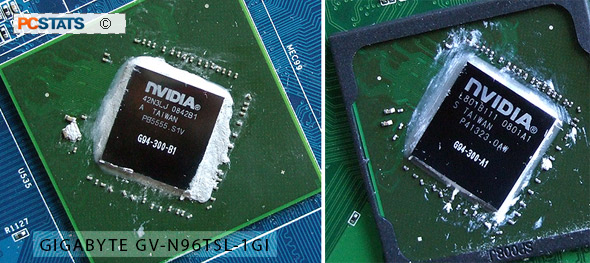
|
This isn't an old 9600GT GPU making a comeback with 1GB of GDDR3 memory, this new Geforce 9600GT graphics card from Gigabyte uses the 'revision B' nVidia 'G94' GPU; it's built with a smaller manufacturing process, has a physically smaller silicon die, uses less power and consequently runs cooler.
85% Rating: 
|
|
|
|
Home >
Reviews >
Video Cards >
Gigabyte GV-N96TSL-1GI |
|
|
nVIDIA GeForce 9600GT Revision B GPU & Power Draw
While NVIDIA still refers to this graphics processor, and
all Geforce 9600GTs by the same 'G94' code name, there are a number of
differences between the GPUs on stock nVidia Geforce 9600GTs and those that
power the Green Edition Geforce 9600GT videocards.
The most obvious is that the overall memory
of the Gigabyte GV-N96TSL-1GI has been increased from 512MB up to 1GB of
GDDR3, which means the videocard can handle larger frame buffers and have
better performance when anti-aliasing is turned up to 8X and 16X values.

Although
standard Geforce 9600GT videocards consume about 95W of power and require a
6-pin PCI Express adapter, the Nvidia G94-300-B1 GPU has received a
die-shrink to 55nm and cut its power draw significantly. The Gigabyte GV-N96TSL-1GI videocard is compatible with the
PCI Express 2.0 bus interface. Nvidia SLI is supported via a single SLI card
edge connector, a maximum of two Geforce 9600 GTs can be linked together in SLI
mode.
Now it's
time to take a look and see just how much power savings a 55nm die-shrink will
mean for the Gigabyte GV-N96TSL-1GI videocard...
Total System Power Draw Comparisons
Here's how the Gigabyte GV-N96TSL-1GI
videocard stacks up in real life. We have no way of directly measuring
motherboard power draw, so PCSTATS measures total system power draw and compares
that in CPU-loaded (max value recorded in 3DMark) and idle states (at Windows
Vista desktop).
An Extech
380803 AC Power Analyzer and A-PFC compliant PC Power and Cooling 750W power supply were used for
these tests.
 Videocard Power
Consumption (Total System Power Draw) Videocard Power
Consumption (Total System Power Draw) |
| Idle at Desktop |
Watts |
Ranking |
| Palit HD4870 X2
2GB |
177 |
   |
| Asus EAH3870 X2
1GB TOP/G/3DHTI/1G/A |
153 |
   |
| Asus EAH3870 X2
1GB TOP/G/3DHTI/1G/A (Crossfire) |
222 |
   |
| MSI
R3870X2-T2D1G-OC |
165 |
   |
| Diamond Viper
Radeon HD 2900XT CrossFire |
195 |
   |
| Asus EAH4850
HTDI/512M |
120 |
   |
| MSI
R4830-T2D512-OC (Radeon 4830) |
108 |
   |
| Asus EAX1900XTX
2DHTV/512M/A |
160 |
   |
| Asus
EAX1950PRO/HTDP/256M/A |
150 |
   |
 Gigabyte
GV-N96TSL-1GI Gigabyte
GV-N96TSL-1GI |
96 |
   |
| nVidia Geforce
9600GTs in SLI |
166 |
   |
| Asus EN9600GT
Top/HTDI/512M |
152 |
   |
| Palit Geforce
9600GT 512 |
151 |
   |
| MSI
NX8800GTX-T2D768E |
196 |
   |
| MSI
NX7950GX2-T2D1GE |
183 |
   |
| MSI
NX7900GTX-T2D512E |
165 |
   |
| Gigabyte
GV-NX76T256D-RH |
140 |
   |
| 3D Loaded: |
Watts |
Ranking |
| Palit HD4870 X2
2GB |
421 |
   |
| Asus EAH3870 X2
1GB TOP/G/3DHTI/1G/A |
390 |
   |
| Asus EAH3870 X2
1GB TOP/G/3DHTI/1G/A (Crossfire) |
610 |
   |
| MSI
R3870X2-T2D1G-OC |
330 |
   |
| Diamond Viper
Radeon HD 2900XT CrossFire |
549 |
   |
| Asus EAH4850
HTDI/512M |
202 |
   |
| MSI
R4830-T2D512-OC (Radeon 4830) |
177 |
   |
| Asus EAX1900XTX
2DHTV/512M/A |
333 |
   |
| Asus
EAX1950PRO/HTDP/256M/A |
252 |
   |
 Gigabyte
GV-N96TSL-1GI Gigabyte
GV-N96TSL-1GI |
160 |
   |
| nVidia Geforce
9600GTs in SLI |
313 |
   |
| Asus EN9600GT
Top/HTDI/512M |
220 |
   |
| Palit Geforce
9600GT 512 |
221 |
   |
| MSI
NX8800GTX-T2D768E |
345 |
   |
| MSI
NX7950GX2-T2D1GE |
315 |
   |
| MSI
NX7900GTX-T2D512E |
277 |
   |
| Gigabyte
GV-NX76T256D-RH |
213 |
   | |
Wow, what a difference a change in manufacturing process
makes! Overall power draw drops by 60W under load when compared to the Asus and
Palit Geforce 9600GT based test systems. A more efficient GPU has
definitely made this card a lot less power-hungry.
PCSTATS will put it through its paces in just a moment, but
first let's see just how far we can overclock the Gigabyte
GV-N96TSL-1GI!
|
